Switzerland is one of the most expensive countries in the world and if it wasn’t for its incredible beauty, many would overlook travel to Switzerland purely because of their budget. However, the Swiss Alps and stunning nature, convince many that backpacking in Switzerland on a budget is worth it. While it may not be a backpacking hub like cheaper destinations around the world, there is definitely a backpacking trail and a budget travel vibe in Switzerland.

A GUIDE TO BACKPACKING IN SWITZERLAND
In this blog post, I will share with you just how expensive Switzerland really is and a list of my best tips to help you with your travels and backpacking in Switzerland on a budget. These are REAL tips that I learned throughout my 3 months of travel in Switzerland. Some of these lessons I learned the hard way!
While you may not be an out-and-out backpacker, many of these tips can help even a regular traveler in Switzerland save lots of money while still enjoying all of the Swiss highlights. If you consider yourself a ‘middle-class’ citizen in Australia or America, you will feel slightly poorer than normal while backpacking in Switzerland.

IS SWITZERLAND EXPENSIVE?
The short answer is YES. I am from Australia, which is also pretty expensive, and lived in Hawaii, U.S.A. for four years. I’ve also traveled to about 40 different countries around the world, just to give you an idea of what my perspective is comprised of. I’m going to do my best below to give you some Switzerland prices for certain items, tickets, and fees for your travels in Switzerland.
I’ll also give you some ideas as to how you can build out your daily budget and what you can expect to spend. Remember this is for travelers who are sightseeing, on the move with public transit and travel. If you lived in Switzerland you could find cheaper alternatives with long-term rentals and yearly discounts for example.
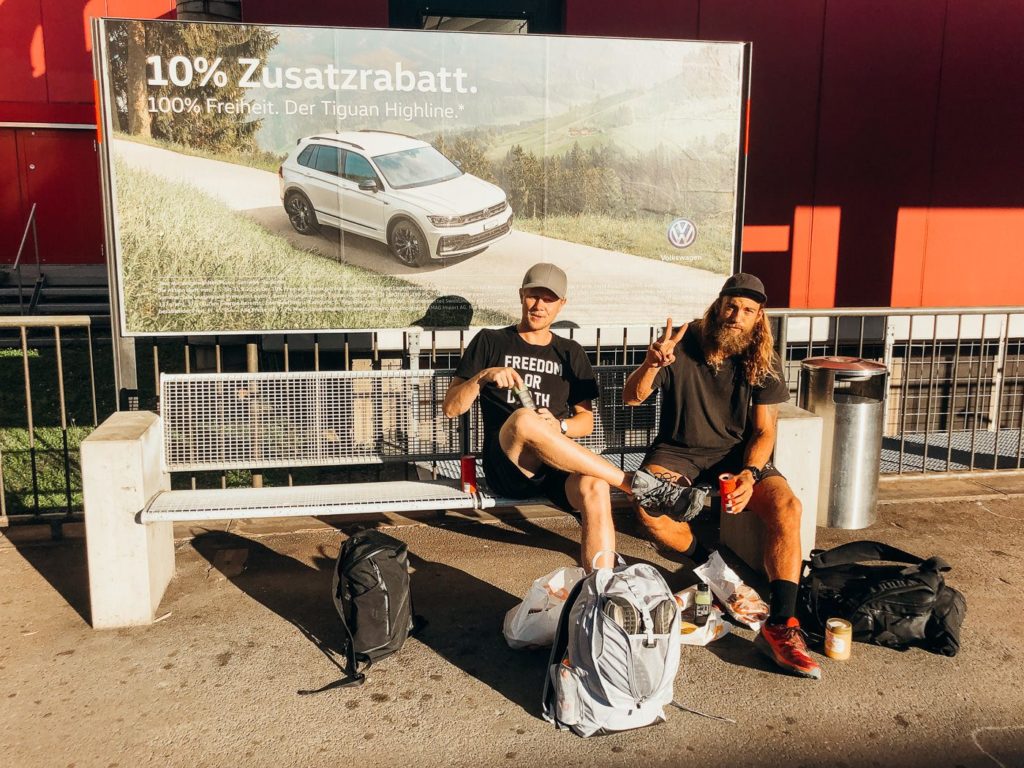
PRICES IN SWITZERLAND
The Swiss Franc is usually close to parity with the US Dollar, which means you get about one Swiss Franc in Exchange for one US Dollar, which makes it easy to calculate on the go for conversions.
Accommodation for Backpacking in Switzerland
There are hostels in almost all towns in Switzerland although some smaller towns didn’t have any hostels at all such as Appenzell. The cheapest hostels in Zurich were $80 USD per night for a bunk bed in a shared dorm including continental breakfast. The cheapest hostel in Zermatt was $80 USD with breakfast (and a view of the Matterhorn). However, the best place cheap place to stay is in Interlaken, where there are lots of hostels and is a central base.
You can find a hostel dorm bed for as cheap as $43 USD in Interlaken including breakfast. I wrote a blog post about why you should stay in Interlaken if you are backpacking in Switzerland and the top hostels to choose from: THE BEST CHEAP PLACES TO STAY IN INTERLAKEN

Price of Restaurants in Switzerland
Restaurants are quite expensive in Switzerland with most meals starting at a minimum of $20 USD for a regular restaurant but if it is fancy, don’t be surprised if you are seeing meals for $40 and $50 USD per person for the cost of food in Switzerland. If you want a beer with your meal, it will cost close to $10 at a restaurant. Most people who are backpacking in Switzerland, stick to the grocery stores for supplies and as a treat, they will have a takeaway or venture into a cafe. Food is second only to accommodation when it comes to the cost of travel in Switzerland.

Price of Grocery Stores in Switzerland
The cost of food in Switzerland at grocery stores is still expensive but not as exorbitant as the restaurants. If you can stick to locally produced items such as cheese, bread, yogurt, milk, and chocolate you can get away without breaking the bank. If you are intolerant to dairy and gluten you will be in for an expensive time in Switzerland!
Many hikers and backpackers will use bread, cheese, and chocolate as staples and then add in fruits and vegetables around those. If you are big into the meat, Switzerland is going to be expensive for you with steaks and meat products costing quite a lot compared to the bread, cheeses, and dairy products.



Price of Transport in Switzerland:
Transit is one of the most expensive parts of backpacking in Switzerland as you really do need to use the trains and buses but they are just so damn expensive. I had a number of days of long travel where my train tickets were close to $100 USD. I’ll go into detail below about how to get the right discounts and passes for the train but to give you an idea, a 30-minute trip can often cost $20 -$30 USD. If there are multiple stops on an hour-long journey and a few different trains, don’t be surprised if the trip is $50+.
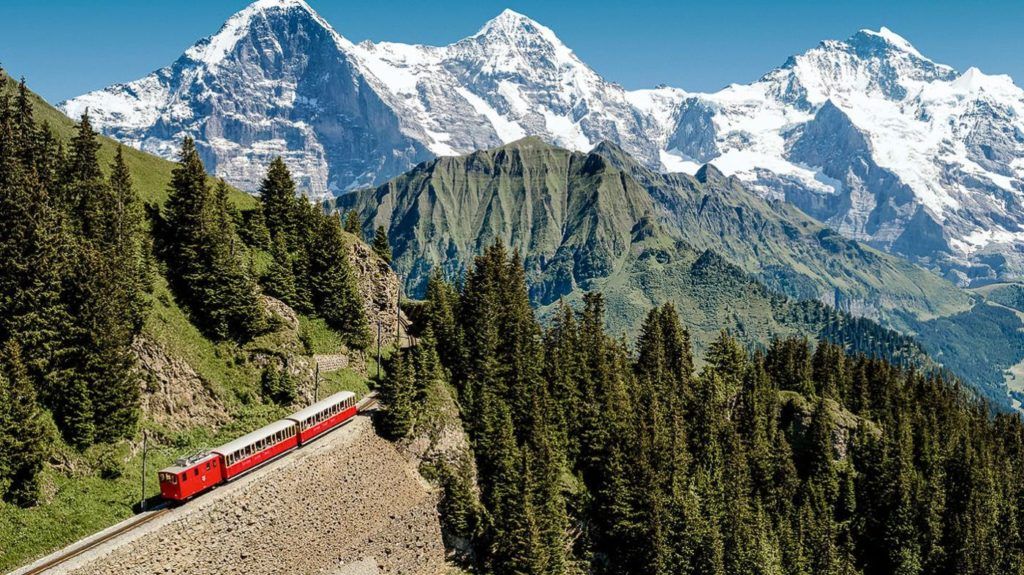
GET A SWISS TRAVEL PASS!
Enjoy UNLIMITED train, boat, and bus rides in Switzerland for up to 15 days. Click to book a flex Swiss Travel Pass or choose the Consecutive Swiss Travel Pass.
The Swiss Travel Pass starts at $260 for 3 days. Click here to check if it’s available on your travel dates.
SWITZERLAND BACKPACKING TRIP: DAILY BUDGET
- Accommodation: $50 to $100 for a hostel if you are solo.
- Food: $30-40 per day if you eat at one cafe and the rest of your meals at your free breakfast and from the grocery store.
- Transport: If you took a train to and from a hike in the Swiss Alps, which would be considered an average day in Switzerland you could expect to pay $20-30 per day on transport (assuming you already had your Half-Fare Card, which I will talk about below)
- Extras: Depending on your travel style you may buy some beers at night, pay for activities, tours, or cable cars to the summit of a mountain. You could expect to spend $20-30 a day on extras.
- Total Daily Expenses in Switzerland: $110-180 USD per day while backpacking throughout Switzerland if you are actively exploring, hiking, and sightseeing around the country. If you just chill in the hostel reading a book, your budget may thank you but you might be missing out on all of the great hikes in Switzerland.
You can definitely do it much cheaper if you are super tight on your budget and skip lunch, just enjoying the free breakfast at your hostel. However, things like the train prices are quite unavoidable so $100 a day is a good place to start. If you are coming for 2 weeks to Switzerland and looking to do a lot of sightseeing, any less than $1400 would be a sign of a great budget backpacker.
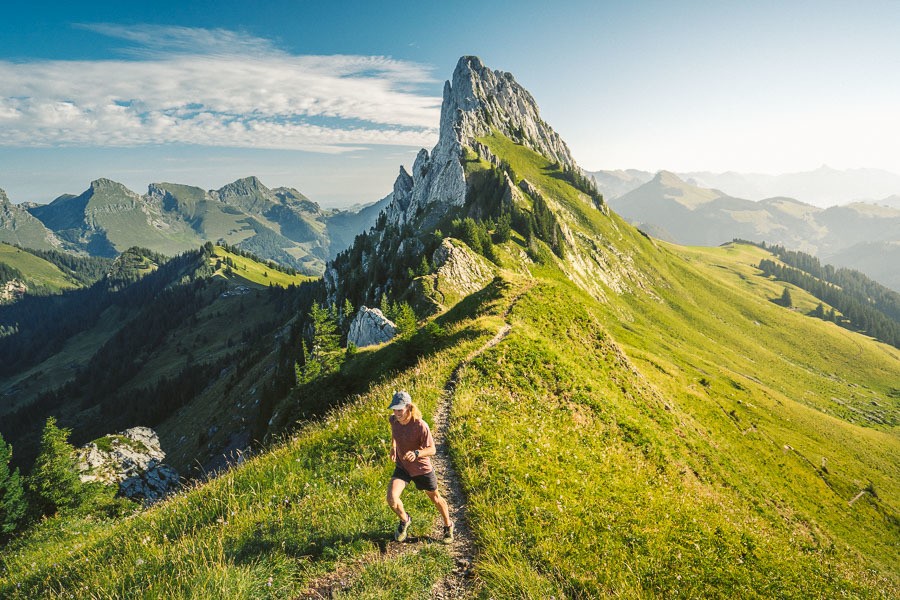
MY TIPS FOR BACKPACKING IN SWITZERLAND ON A BUDGET
These are my personal tips for backpacking in Switzerland. The most important is nailing the transport but they are all valuable bits of advice that could save you quite a bit of cash while backpacking through Switzerland.
I backpacked around Switzerland by using trains and buses. Unless you rent a car (not cheap) this is how most people get around. They are very efficient, have good route coverage, and are also very damn expensive.
When I say expensive, I mean it. In my first week in Switzerland, I took a train from Zurich to the Oescheninsee hike, and on the return trip my ticket was $100 USD for the day and it blew my socks off. I wasn’t sure how I would afford another 3 months in this country.
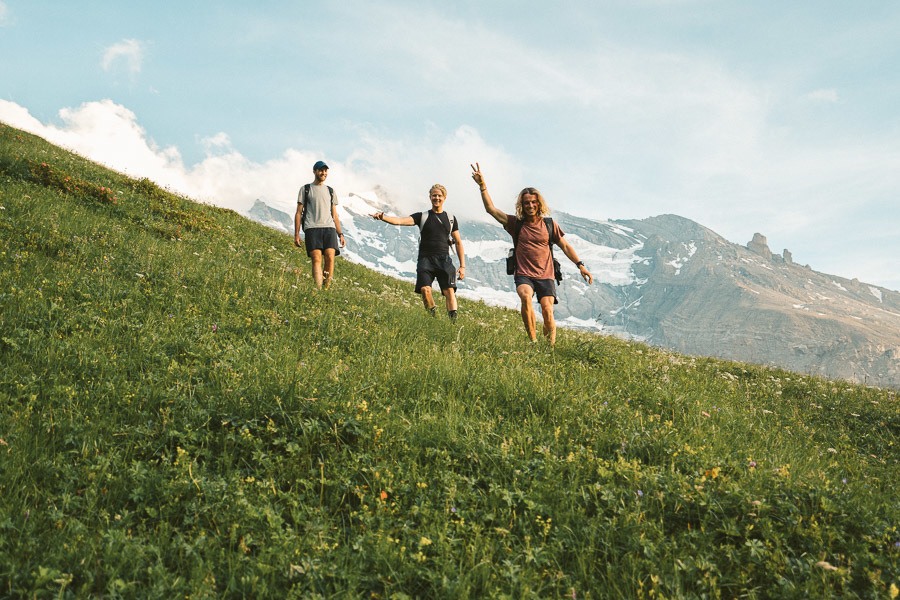
SWISS TRAVEL PASS or HALF-FARE CARD
OPTION 1: Buy the Swiss Half Fare Card: Switzerland trains, buses, and cable cars are EXPENSIVE! I found the best way to get around cheaply was to buy the Swiss Half-Fare Card before I arrived. It gives you 50% off every regular train, bus, and even many cable cars. It only costs $150 USD but pays itself off in just a few days with many train tickets in Switzerland costing close to $100 alone. If you are staying for more than 5 days, I suggest buying the Swiss Half-Fare Card.
OPTION 2: Buy the Swiss Travel Pass: The second option is to get the Swiss Travel Pass, which gives you unlimited train, bus, and (many) cable car rides but it’s pretty expensive at around $100 USD per day so if you don’t travel each day it isn’t worth it.
OPTION 3: Buy the FLEXI Swiss Travel Pass: The final (BEST) option is to get the FLEXI Swiss Travel Pass, which allows you to buy 8 days’ worth of transit but you can choose the night before if you want to activate the next day. That way you don’t need to travel every day to get your money’s worth, you can just activate the FLEXI Swiss Travel Pass on the days when you are doing sizeable transits. My advice is to book the Swiss Half-Fare Card or the FLEXI Swiss Travel Pass in advance before your trip so it’s ready to go when you arrive.
GET A SWISS TRAVEL PASS!
Enjoy UNLIMITED train, boat, and bus rides in Switzerland for up to 15 days. Click to book a flex Swiss Travel Pass or choose the Consecutive Swiss Travel Pass.
The Swiss Travel Pass starts at $260 for 3 days. Click here to check if it’s available on your travel dates.

WHERE IS THE CHEAPEST PLACE TO BASE IN SWITZERLAND?
This is a question I can’t completely answer without knowing your budget and motives. However, I can make a few broad suggestions about how to travel backpackers in Switzerland based on my 100-day journey around Switzerland.
If you are keen on hiking or at least viewing the mountains. I highly advise you to stay in Interlaken. I’ll go through a few key reasons that make Interlaken the best home base for your adventures.
- Price: Interlaken is relatively cheaper than most other towns. It has luxury resorts and hotels don’t get me wrong but it has more budget options than most towns. For example, in Zurich, the cheapest hostel I could find was $80 USD and in Interlaken, I stayed at a hostel for $40 USD including breakfast, two coffees per day, free locker storage, and $2 washing/drying machines.
- Location: Interlaken is a hub. If you stay in Murren, Wengen, or Lauterbrunnen you are in a great spot but you are very deep in and to get anywhere else becomes a bit of a journey. Especially if you want to go anywhere other than the Jungfrau region you are in for a long-haul trip. I was based in Interlaken for several weeks and was able to catch the train to Grindelwald in under 45 minutes, Lauterbrunnen in under an hour, and also Thun and Brienz in half an hour. You are more central and I would do things like go up to Murren at midday, do the Via Ferrata, and head home to Interlaken.
- Interlaken is quite a scenic town itself with lots to do like the Harder Kulm viewpoint, the epic Hardergrat Trail, the Schynige Platte Hike, and activities like Paragliding over the lake.

I created a couple of guides to help you investigate the best places to stay in Interlaken depending on your budget. There are a lot of budget hotels and hostels but also some traditional, stunning hotels. Here are the guides I wrote:
- A Guide to Interlaken Accommodation: WHERE TO STAY IN INTERLAKEN
- Interlaken Budget Accommodation: BEST CHEAP PLACES TO STAY IN INTERLAKEN

MOUNTAIN HUTS IN SWITZERLAND ARE A BUDGET TRAVEL HACK
While you are hiking in Switzerland, it is inevitable you will come across some incredible mountain huts. I didn’t know much about the hut culture in Switzerland but once I was in on it, I loved it. Basically, the mountain huts are kind of like mountain cabin hotels. They usually have a restaurant and also a number of dormitory-style rooms.
For average-sized huts, it is common for a family to live up in the hut on the mountain during the summer and hiking season and visitors can book a night or more up at the hut. When they arrive they have dinner and breakfast included in their nightly fee. I stayed overnight at five different huts (which were listed above) and most ranged from about $60 a night to $100 a night per person including breakfast and dinner. You may not think that is a very ‘budget’ price but if a hostel back in town (with no epic view) is $40-90 per night with no meal included then $60-80 with breakfast and dinner included while high up in the mountains is a value deal.

The ‘huts’ are actually pretty fancy and have heating, nice restaurants, a balcony, alcohol, games, books, and much more. All you need to bring is a sleeping bag liner and your hiking gear and you are set.
You can also shower at most of the huts (usually included in the price also). I always did a one-night stay so I would hike up, watch the sunset and stay the night. I would then hike at sunrise and explore further on before hiking back down.
Many hikers like to do hut-to-hut mountain hiking, which means you map out several huts that are within hiking distance of each other and you do a multi-day trek where each night you will make it to a new mountain hut on the connecting trails throughout the Swiss Alps. It’s a great way to hike because you don’t need to carry all of your food, heavy camping gear, or warmer clothes for the cold nights outside. You do all your eating at the hut restaurants and carry a few snacks with you and sleep in the comfort of the cabin dormitories. If you are in Switzerland in the summer, I can’t recommend it enough.

The other key point to remember is that most meals in Switzerland are $20-$40 at least so when you consider you are getting two meals included, the accommodation is really only $30-40 per night, which will be the cheapest accommodation you find in Switzerland but the best view!

If you are planning to stay at a lot of mountain huts you can buy a Swiss Alpine Club (SAC) membership, which also involves a rescue service if you get stuck on the mountain. This membership gives you a discount of usually 40-50% off the regular price of the hut price. It costs about $80 USD for the yearly membership so after three overnight stays you have made your money back and you are supporting the mountain hut owners of Switzerland, who you will see are all really nice families.

You can click on one of the following links to visit my blog post about the mountain huts I visited. I stayed at Gleckstein Hut, Trift Hut, Ebenalp Hut, Baregg Hut and visited many others while passing through on hikes in Switzerland.

STAY ON THE OUTSKIRTS OF A POPULAR TOWN
Because Switzerland has such an efficient transport system with trains and buses you can often stay just outside of a popular tourist town at a much cheaper accommodation price but only be a 5 or 10-minute train trip from that town center. For example, while basing in Interlaken I found a hotel that was half the price of most hotels in Interlaken and it turned out to be one train stop away in a small town called Wilderswil. The train passed by this stop every 10-15 minutes and I was basically staying in Interlaken but at half the price.
Sometimes just a little bit of research like that about where the trains stop and where the hotel is located can be the difference between $200 per night for a hotel room or $90 per night for a hotel room.

TRAVEL SLOWLY AND PICK 2 DESTINATIONS NOT 10
When people travel to Switzerland they quickly get overwhelmed. They’ve heard about the great hikes in Zermatt but also that Grindelwald is a must-visit. They are told they need to explore Interlaken but Zurich and Bern must be on their bucket list. Before you know it there are ten hotspots around Switzerland on your two-week itinerary and you are doing more transits than actual sightseeing while backpacking in Switzerland.
That is how beginners travel and how you waste your money on pointless train trips. Experienced travelers realize they can’t ‘see it all’ and instead, they choose several locations that stand out to them and align with their personal travel style, or preference. They then spend multiple days or even a week in each location and really get to know that area, enjoy the surroundings, and are very productive with their sightseeing due to their fixed base. They also save lots of money on transit and can cook some meals at their accommodation and settle in a little bit.
This is exactly what I did in Interlaken for several weeks but also in Chur for two weeks, Fribourg for three weeks and Zermatt for eight days. Don’t try and ‘tick off’ as many locations as possible just so you can go home and tell your friends ‘I’ve been there’. Travel slowly and you will find you have a better vacation and you spend your money on experiences rather than getting to and from all of the places you have on your lengthy list.

CAN YOU DRINK THE TAP WATER?
The tap water was one of my favorite parts of Switzerland. After traveling through Asia for many years, I was used to the constant battle to find safe drinking water without buying wasteful plastic bottles. In Switzerland, the water is 100% safe to drink from taps in buildings and it even goes one step further. This is a great way to save money while in most towns and even trails have fountains and taps installed (often very intricate and beautiful fountains) and you can fill your bottle up straight from the fountain.
With so many glaciers and alpine regions, there is no shortage of fresh, clean water in Switzerland. I always carry a Hydroflask with me and keep it full all the time so I can stay hydrated and save money on buying drinks.

VIA FERRATA IS THE CHEAPEST ADRENALINE ACTIVITY
For those who don’t know what a Via Ferrata is, it’s basically a series of ladders, steps, and rock climbing that leads you up a wall. You are wearing a harness and clip into a strong wire at the start of the Via Ferrata.
From that point, you are always clipped in with at least one clip. Every 10 steps or so, you reach a new section of wire and you unclip one Carabiner clip from the old section and attach it to the new section. Once it is firmly secured, you unclip the second clip from the old section and also add it to the new section so you now have two Carabiner clips in the new section and you move another ten steps.
I had never heard of it before Switzerland but it fast became one of my favorite activities. I did four Via Ferrata courses across Switzerland and they were definitely a highlight of my trip.
Compared to $160 for a 10-minute skydiving or paragliding experience, renting the Via Ferrata gear is usually just $20 and the course is free just like a regular hike in the Swiss Alps. The course often lasts 2-3+ hours so you are getting a whole day activity that is genuinely awesome for super cheap rather than a 5-minute experience for a week’s budget! You can click any of the links for the places I did a Via Ferrata in so you can check out those specific blogs. My Favorite Via Ferrata experiences were: Murren to Gimmelwald Via Ferrata, Furenalp Via Ferrata, Rotstock Via Ferrata, and Pinut Via Ferrata.


HELICOPTERS, PARAGLIDING, SKYDIVING, CANYONING = BUDGET BREAKERS
Switzerland is a land of adventure and adrenaline activities are available in most towns. However, compared to many countries they are incredibly expensive. A tip I would pass out is to just pick one and do it in Switzerland so you can enjoy being up in the air near the Alps.
However, most people only do one bungee or one skydive in their life and you can do it in many other countries for half the price so maybe it’s best to go hiking for free rather than do a $160 USD tandem paraglide while backpacking in Switzerland. It’s just not bang for your buck when you could do it for under $100 in most countries around the world.
The hiking is free and it’s awesome so just make the most of that if you are on a tight budget! Having said that, I did get to go paragliding and on a canyon swing and they were awesome but it was a collaboration so I didn’t have to pay for them. I probably wouldn’t have done them otherwise. Just some transparency there.

NEVER EAT AT A RESTAURANT
If you’ve got the cash, go for it. Buy all the Swiss fondue you can stomach but if you are more into the travel and adventure and less stoked on the cultural food and dining, just skip the restaurants. If you have table service in Switzerland you can guarantee you are forking out $20+ as a bare minimum.
I basically avoided restaurants but still ate out a lot. The workaround is to order a pizza, find a lower-class cafe, hole-in-the-wall Thai restaurant, or the trusty old grocery store. Swiss grocery stores like COOP and Migros actually have some good quality, fresh food and I loved the muesli bowls, pre-made pizzas, bread, cheeses, and fresh juices.
Basically, what you can get for under $20 in a grocery store compared to one meal at a restaurant is a huge difference and something to consider when trying to stretch your Switzerland budget. Below you can see us after a long (very late) hike, giving in to the temptation of an expensive restaurant pizza. One of the few times we couldn’t resist a beautiful meal in Switzerland.

YOU DON’T NEED A GUIDE
Yes, if you are climbing a 4000+ meter high mountain in the snow then get a guide but for almost everything else in Switzerland, you won’t need a guide. If you want one then go ahead but if you are relatively street smart then you will be fine touring yourself around. Switzerland is one of the most well-signed countries I’ve ever been to. Signs tell you exactly which path to take, and how long it will take you to get there.
The trains are easy to navigate and Google Maps has you covered navigating the relatively simple transport system. It’s all set up for you to DIY your whole trip and with some basic planning, you will be able to move efficiently around the country and see the sights without jumping on tours or group outings that can cost $100+ per day and blow your budget quickly while backpacking in Switzerland.

FREE OUTDOOR GYMS IN SWITZERLAND
Switzerland is one of the most expensive countries in the world so you would expect working out to cost you an arm and a leg also. However, we found out that there are lots of outdoor gym courses hidden in the forests of Switzerland. It’s a bit strange but pretty cool when you see the locals actually using them.
Basically, there’s an app and a website called Zurich Vita Parcours and you can just search your location and find the nearby outdoor gyms. They are often set up at several stations in a little forest course so you have to walk or jog between them. Josh and I found lots throughout our trip and they were really well equipped and kept us in shape. This is one of my top tips for traveling in Switzerland, especially if you are there for an extended period of time


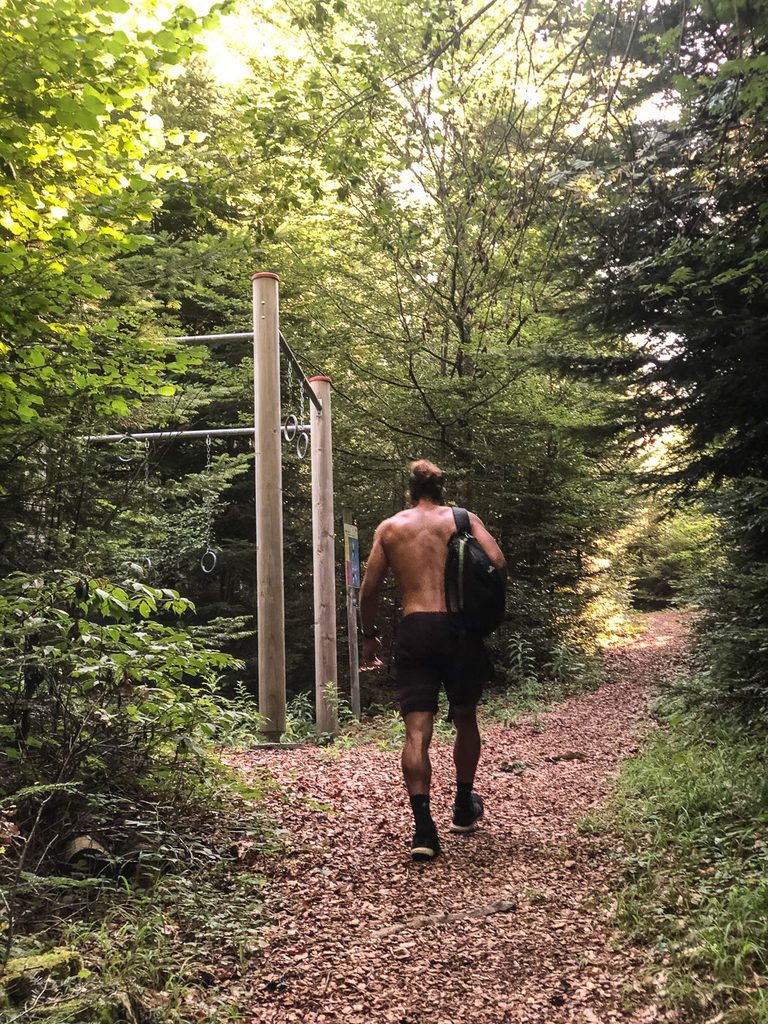
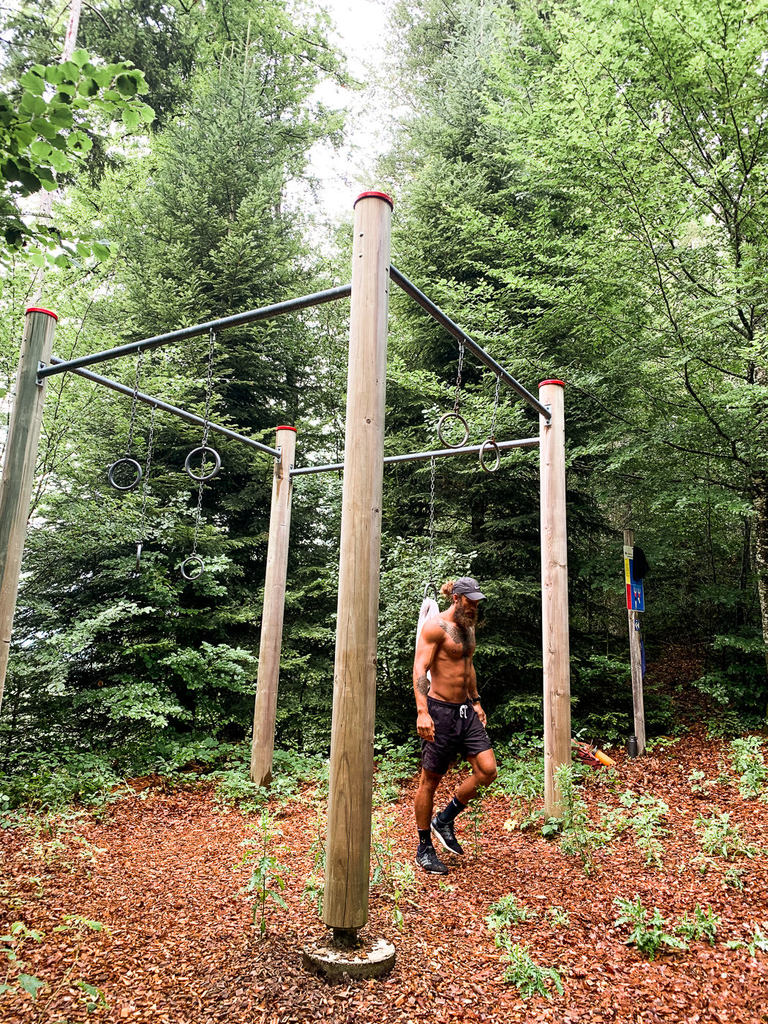
THE BEST VALUE FOOD IN SWITZERLAND
I’ve established by now that Switzerland is very expensive so, of course, the food is right up there with things you probably can’t afford while on your Swiss tour. Meals can cost upwards of $30 and eating at restaurants just isn’t an option for many travelers who frequent the grocery store and smaller cafes. Let’s face it, if you are budget-backpacking in Switzerland you won’t find yourself sitting down at a restaurant too often!

However, if you don’t find yourself at a restaurant or mountain hut go for the soup and ask for extra bread. Here are a few reasons why soup is always the best option:
- The soups throughout Switzerland are amazing and they are a bit of a specialty with a unique recipe at every mountain hut or cute restaurant.
- Soup is usually half the price of any meal but when the free side of the bread is added in, it’s usually just as filling.
- It will warm you up on a chilly adventure.
- You can usually ask for an extra bit of bread and for just $8-12 you have filled yourself up instead of a $25+ pasta or regular meal.

RENT A CAR … ACROSS THE BORDER
Switzerland is expensive… you get it! However, there is a little hack for those who are willing to put in some effort to save a few dollars. I know a number of people who rented a van or a car in Germany, filled up with groceries, and then drove into Switzerland.
Germany is much cheaper than Switzerland for fuel, groceries, and car rental so if you can do your big shopping trip and vehicle rental across the border and then drive into Switzerland you could make some big savings! Sleeping in a car or van is one of the smartest moves if you are backpacking in Switzerland because then you can save money on train tickets and accommodation!

HIKE YOUR WAY TO THE SUMMIT AND SAVE ON CABLE CAR TICKETS
It might sound obvious but you can actually save quite a lot of money if you hike up or down from a mountain summit instead of using the cable car. Tickets to the summit can often be between $30 and $50 USD return so if you hike one way or even both you can save enough money to cover your entire day of food. You’ll grow some serious quads and glutes as well if you start attacking the inclines each day. I’m speaking from personal experience here.
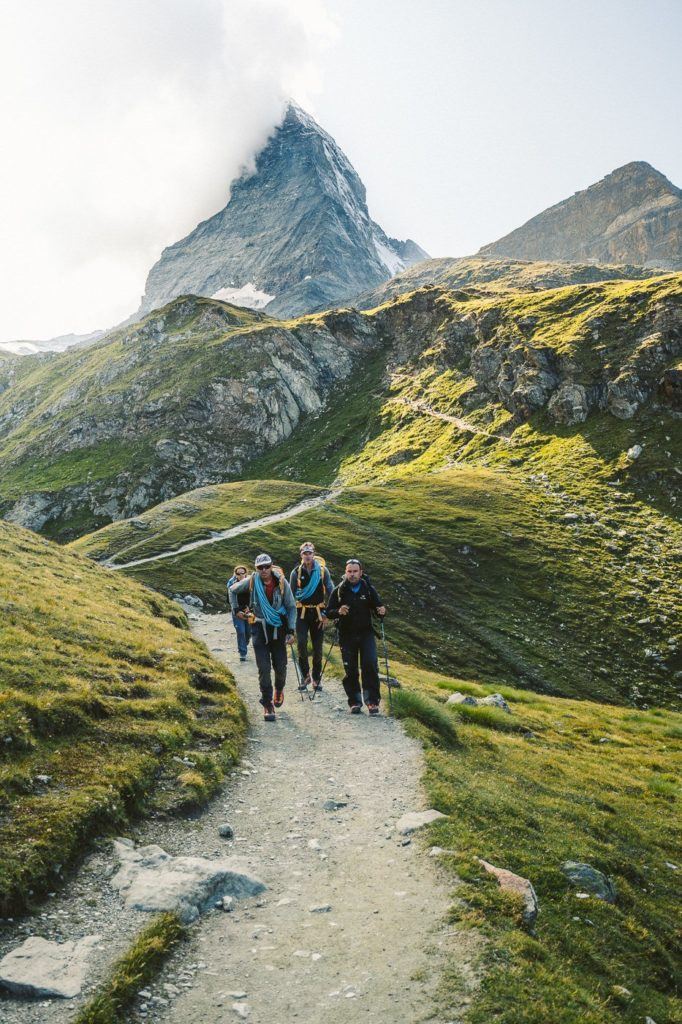
AIRBNB TURNED OUT TO BE BETTER VALUE THAN HOSTELS & HOTELS
We managed to find several Airbnb’s for $60 USD or less per night that offered great value rather than a minimum of $100 USD for a hotel room or $60-$80 USD for a bunk bed in a dorm. I stayed in a private room in Appenzell for $45 USD per night. It was the house of an older lady who was super nice and instead of a bunk bed and a locker I had my own private room could use the bathroom and kitchen and didn’t have to lock my gear in a locker during the day. The cheapest hotel in Appenzell was $150 USD.
You can also find a number of great apartments or chalets where you can rent the entire place for yourself. If you are in a group of 2 or more this can start to be great value when you split the price amongst your group rather than all needing separate hotel rooms. I used Airbnb in Chur, Appenzell, Zurich, Interlaken, and Grindelwald throughout my stay and found it incredibly good value compared to the hotels, and all of the hosts were super nice. Even if you are backpacking in Switzerland, you can still stay in an Airbnb rather than a hostel and actually find you are staying within your budget better than in the hostels!
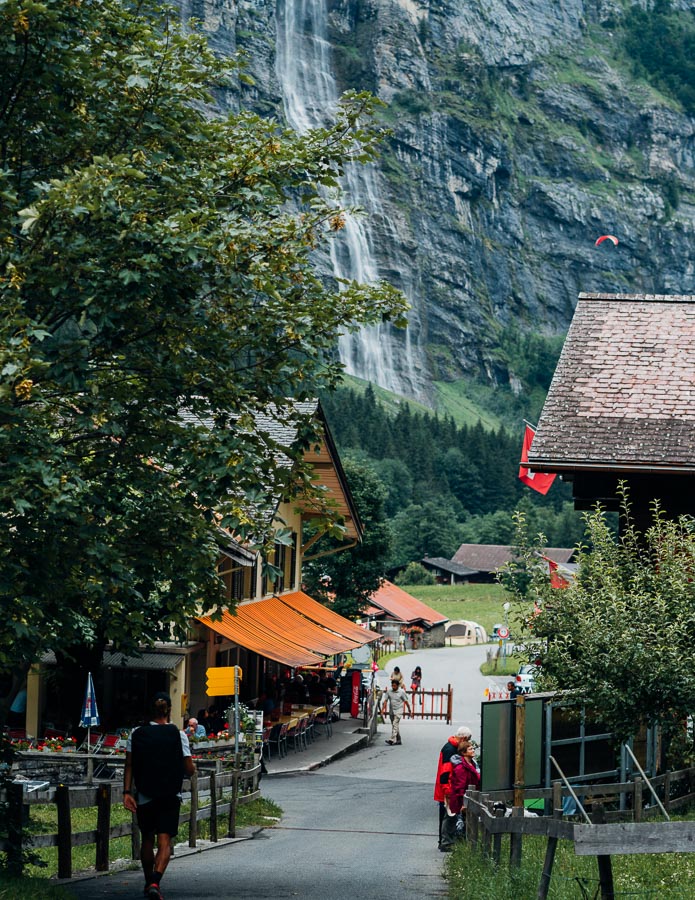
I hope this has been a helpful Switzerland backpacking guide for budget-conscious travelers. I know I found Switzerland expensive but with these tips and some help from a few locals, I managed 100 days backpacking in Switzerland without going completely broke!
MY SWITZERLAND HIKING GUIDES
I spent 100 days hiking in Switzerland and created a guide for different regions around the country. You can click on one of my Switzerland hiking guides below to help you plan your trip.
- The Complete Guide: 50 AWESOME HIKES IN IN SWITZERLAND
- The Via Ferrata Guide: 4 EPIC SWITZERLAND VIA FERRATA COURSES
- Lauterbrunnen Guide: 10 AWESOME HIKES NEAR LAUTERBRUNNEN
- Interlaken Guide: 15 AWESOME HIKES IN INTERLAKEN
- Grindelwald Guide: 12 AWESOME HIKES NEAR GRINDELWALD:
- Mürren Guide: 7 AWESOME HIKES IN MURREN
- Appenzell Guide: 9 AWESOME HIKES NEAR APPENZELL
- Chur Guide: 7 AWESOME HIKES NEAR CHUR

MY SWITZERLAND TRAVEL TIPS
- For Backpackers: SWITZERLAND BUDGET BACKPACKING GUIDE
- Travel Tips: 20 THINGS TO KNOW BEFORE VISITING SWITZERLAND
- Transport Tips: RENTING AND DRIVING A CAR IN SWITZERLAND
- Accommodation Guide: 30 BEST PLACES TO STAY IN SWITZERLAND





Dee
Sunday 31st of March 2024
Amazing blog !
This is the kinda thing that I was searching for ; explanations, answers and suggestions 🩷
Will definitely be using this as a guideline
Saa
Sunday 3rd of December 2023
Very useful information. Thank you for the write up.
Monday 7th of August 2023
Dude, really awesome blog! Thanks for the details and ideas!
Stan
Monday 3rd of July 2023
I'm a foreigner in Switzerland, but I find it not that expensive. The first mistake is go shop in Coop, that is a really overpriced place, simple crap costs an arm and a leg. Denner is the solution you need. Sometimes some Turkish shops, but they're scarce. As I've transitioned to carnivore a while ago, I really spend little money on meat and eggs. And this is my staple, really affordable.
The rest is quite interesting and accurate I believe.
Daniela Kovalcik
Thursday 11th of May 2023
Hi Jackson, what a fabulous blog with all the great ideas of saving money and exploring my home country. I live in the United States but was born in Switzerland and I'm impressed how you are hitting the nails on the head with all your recommendations. I have never slept up in the mountains after a hike and just added this adventure to my bucket-list. There is one thing I think you should mention in your Swiss blog as well, and that is the fact, that Luzern is one of the most beautiful cities in Switzerland and not to miss a couple of days there. Zurich and Bern are okay, but Luzern takes the crown :) There are a couple of Hostels to pick from as well. My husband and I did the hike up to Mount Pilatus and it was fabulous. You hike up on the Alpnach side and then you go down with the Gondola on the other side to Fraekmuend for the Frakigaudi Toboggan run! Adults and kids will love it equally! All the best, Daniela